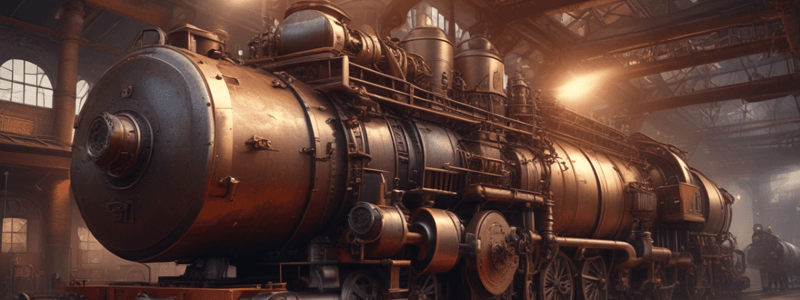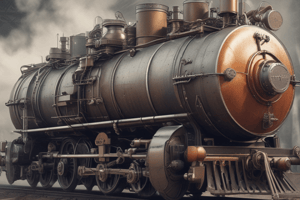Podcast
Questions and Answers
A steam engine is a type of internal combustion heat engine.
A steam engine is a type of internal combustion heat engine.
False (B)
Steam turbines are no longer used today for generators.
Steam turbines are no longer used today for generators.
False (B)
A steam engine requires a turbine to convert thermal energy into work.
A steam engine requires a turbine to convert thermal energy into work.
False (B)
The power source for a steam engine can only be wood, coal, or oil.
The power source for a steam engine can only be wood, coal, or oil.
Steam engines rely on the power of water to operate.
Steam engines rely on the power of water to operate.
The expansion of steam in a steam engine acts on the gearbox directly.
The expansion of steam in a steam engine acts on the gearbox directly.
Steam engines were never used in locomotives.
Steam engines were never used in locomotives.
A steam engine can utilize any heat source to boil water.
A steam engine can utilize any heat source to boil water.
Steam power cannot move the lid off a kettle.
Steam power cannot move the lid off a kettle.
Using a larger pot to boil water will decrease the power of steam generated.
Using a larger pot to boil water will decrease the power of steam generated.
What was the primary advantage of Watt's steam engine over the Newcomen steam engine?
What was the primary advantage of Watt's steam engine over the Newcomen steam engine?
Which of the following was NOT one of Watt's inventions or improvements to the steam engine?
Which of the following was NOT one of Watt's inventions or improvements to the steam engine?
When was the Boulton-Watt Company established?
When was the Boulton-Watt Company established?
What was the significance of Watt's steam engine invention?
What was the significance of Watt's steam engine invention?
Which statement best describes the overall impact of Watt's contributions to the steam engine?
Which statement best describes the overall impact of Watt's contributions to the steam engine?
Flashcards are hidden until you start studying




